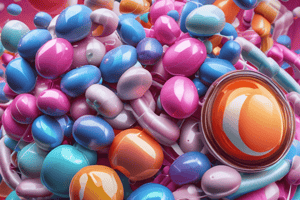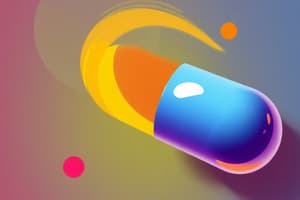Podcast
Questions and Answers
What is the primary focus of pharmaceutics?
What is the primary focus of pharmaceutics?
- The science of dosage form design (correct)
- The study of disease pathology
- The synthesis of new chemical entities
- The marketing of pharmaceutical products
Which of the following studies what the body does to a drug?
Which of the following studies what the body does to a drug?
- Pharmacodynamics
- Drug Delivery
- Pharmacokinetics (correct)
- Biopharmaceutics
What type of drug delivery system releases the drug immediately after administration?
What type of drug delivery system releases the drug immediately after administration?
- Extended-release
- Immediate-release (correct)
- Delayed-release
- Targeted-release
Which of the following is a solid dosage form?
Which of the following is a solid dosage form?
What type of capsule typically contains dry, powdered ingredients?
What type of capsule typically contains dry, powdered ingredients?
Which semi-solid dosage form generally contains the least amount of water?
Which semi-solid dosage form generally contains the least amount of water?
What is the process by which a drug enters the bloodstream?
What is the process by which a drug enters the bloodstream?
Where does drug metabolism primarily occur in the body?
Where does drug metabolism primarily occur in the body?
Which process involves reducing the particle size of drug substances?
Which process involves reducing the particle size of drug substances?
What does GMP stand for in the context of pharmaceutical manufacturing?
What does GMP stand for in the context of pharmaceutical manufacturing?
Flashcards
Pharmaceutics
Pharmaceutics
The science of dosage form design, converting chemicals into safe and effective medication.
Drug Delivery
Drug Delivery
Introduction of drugs into the body, including absorption, distribution, metabolism and excretion.
Dosage Form Design
Dosage Form Design
Designing pharmaceutical products to ensure they are effective and safe for patient use.
Biopharmaceutics
Biopharmaceutics
Signup and view all the flashcards
Pharmacokinetics
Pharmacokinetics
Signup and view all the flashcards
Pharmacodynamics
Pharmacodynamics
Signup and view all the flashcards
Immediate Release
Immediate Release
Signup and view all the flashcards
Delayed-Release
Delayed-Release
Signup and view all the flashcards
Dissolution
Dissolution
Signup and view all the flashcards
Good Manufacturing Practices (GMP)
Good Manufacturing Practices (GMP)
Signup and view all the flashcards
Study Notes
- Pharmaceutics is the science of dosage form design.
- It involves converting a new chemical entity (NCE) or an old drug into a medication to be used safely and effectively by patients.
- It also deals with the formulation, manufacturing, stability, and effectiveness of pharmaceutical dosage forms.
Key Areas in Pharmaceutics
- Drug Delivery: Focuses on how drugs are introduced into the body, including rates of absorption, distribution, metabolism, and excretion.
- Dosage Form Design: Designing pharmaceutical products to ensure they are both effective and safe for patient use.
- Biopharmaceutics: Studies the factors influencing the bioavailability of a drug in humans or animals and uses this information to optimize a drug product's therapeutic efficacy.
- Pharmacokinetics: Examines what the body does to a drug (absorption, distribution, metabolism, excretion).
- Pharmacodynamics: Examines what the drug does to the body, involving the drug's mechanism of action and its biochemical and physiological effects.
Drug Delivery Systems
- Immediate Release: Designed to release the drug immediately after administration.
- Modified Release: Includes extended-release, delayed-release, and targeted-release systems.
- Extended-Release: Allows a reduction in dosing frequency compared to immediate-release formulations.
- Delayed-Release: Releases the drug at a time other than immediately following administration.
- Targeted-Release: Delivers the drug to a specific site in the body.
Dosage Forms
- Solid Dosage Forms: Include tablets, capsules, powders, granules, and suppositories.
- Tablets: Solid preparations usually prepared by compressing powders or granules.
- Can be formulated for immediate-release or modified-release.
- Different types of tablets include compressed tablets, sugar-coated tablets, film-coated tablets, enteric-coated tablets, and effervescent tablets.
- Capsules: Solid dosage forms in which the drug is enclosed within a hard or soft soluble container or shell.
- Hard gelatin capsules typically contain dry, powdered ingredients or miniature pellets.
- Soft gelatin capsules are used for oils and drugs that are dissolved or suspended in oil.
- Powders: A mixture of finely divided drugs or chemicals in a dry form.
- Granules: Prepared agglomerates of powdered materials, which may be used for tablets or capsules.
- Semisolid Dosage Forms: Include ointments, creams, gels, and pastes.
- Ointments: Semisolid preparations intended for external application to the skin or mucous membranes.
- Usually contain less water and are more greasy than creams.
- Creams: Semisolid emulsions, usually containing more than 20% water and volatiles and/or less than 50% hydrocarbons, waxes, or polyethylene glycols.
- Gels: Semisolid systems consisting of dispersions of small or large molecules in an aqueous liquid vehicle rendered jelly-like by the addition of a gelling agent.
- Pastes: Semisolid dosage forms that contain a high proportion of solid ingredients.
- Liquid Dosage Forms: Include solutions, suspensions, emulsions, syrups, elixirs, and injections.
- Solutions: Liquid preparations that contain one or more dissolved drugs in a suitable solvent.
- Suspensions: Liquid preparations consisting of solid particles dispersed throughout a liquid vehicle.
- Emulsions: A dispersion of one liquid in another immiscible liquid, stabilized by an emulsifying agent.
- Syrups: Concentrated aqueous solutions of a sugar, usually sucrose.
- Elixirs: Clear, sweetened hydroalcoholic liquids intended for oral use.
- Injections: Sterile, pyrogen-free preparations intended for parenteral administration.
Biopharmaceutics
- Absorption: The process by which a drug enters the bloodstream from its site of administration.
- Influenced by factors like drug solubility, particle size, dosage form, route of administration, and physiological factors.
- Distribution: The process by which a drug is transported throughout the body to various tissues and organs.
- Affected by factors such as blood flow, tissue permeability, and binding to plasma proteins.
- Metabolism: The process by which the body chemically modifies a drug, usually to make it more water-soluble for excretion.
- Primarily occurs in the liver, but can also occur in other tissues.
- Excretion: The process by which the body eliminates a drug and its metabolites.
- Primarily occurs through the kidneys (in urine), but can also occur through the liver (in bile), lungs (in exhaled air), and other routes.
- Bioavailability: The fraction of an administered dose of unchanged drug that reaches the systemic circulation.
- Influenced by drug properties, dosage form, and route of administration.
- Bioequivalence: The comparison of bioavailability between different formulations of the same drug.
Pharmaceutical Manufacturing
- Formulation: The process of developing a dosage form that is both safe and effective.
- Includes selecting appropriate excipients (inactive ingredients), determining the optimal drug concentration, and designing the manufacturing process.
- Mixing and Blending: Combining different ingredients to achieve a homogenous mixture.
- Particle Size Reduction: Reducing the particle size of drug substances to improve dissolution and bioavailability.
- Techniques include milling and micronization.
- Granulation: The process of aggregating powder particles into larger, more uniform granules.
- Improves flow properties and compressibility for tablet manufacturing.
- Drying: Removing moisture from granules or powders to improve stability and flow.
- Tablet Compression: Compressing granules or powders into tablets using specialized equipment.
- Coating: Applying a thin layer of material to the surface of a tablet or capsule for various purposes, such as masking taste, protecting the drug, or controlling drug release.
- Sterilization: Eliminating microorganisms from pharmaceutical products and equipment.
- Methods include autoclaving, filtration, and radiation.
Stability
- Chemical Stability: The extent to which a drug retains its chemical integrity and potency over time.
- Physical Stability: The extent to which a dosage form retains its physical properties (e.g., appearance, hardness, dissolution rate) over time.
- Microbiological Stability: The extent to which a dosage form resists microbial contamination and growth.
- Factors Affecting Stability: Temperature, humidity, light, pH, oxygen, and interactions with excipients.
- Shelf Life: The period during which a drug product is expected to remain within its specifications if stored under recommended conditions.
Physicochemical Properties of Drugs
- Solubility: The ability of a drug to dissolve in a solvent.
- Impacts absorption and bioavailability.
- Dissolution: The process by which a solid drug dissolves in a liquid.
- A critical step for oral absorption.
- Partition Coefficient: A measure of a drug's relative affinity for two immiscible solvents (e.g., water and oil).
- Influences drug distribution and permeation through biological membranes.
- pKa: The pH at which a drug is 50% ionized and 50% unionized.
- Affects drug solubility and absorption.
- Polymorphism: The ability of a drug to exist in different crystalline forms.
- Different polymorphs can have different physical properties (e.g., solubility, dissolution rate).
Regulatory Aspects
- Good Manufacturing Practices (GMP): A set of guidelines that ensure pharmaceutical products are consistently produced and controlled according to quality standards.
- Food and Drug Administration (FDA): The regulatory agency responsible for approving and regulating drugs in the United States.
- Investigational New Drug (IND) Application: An application submitted to the FDA to request permission to begin clinical trials on a new drug.
- New Drug Application (NDA): An application submitted to the FDA to request approval to market a new drug.
- Abbreviated New Drug Application (ANDA): An application submitted to the FDA for approval to market a generic drug product.
Studying That Suits You
Use AI to generate personalized quizzes and flashcards to suit your learning preferences.




